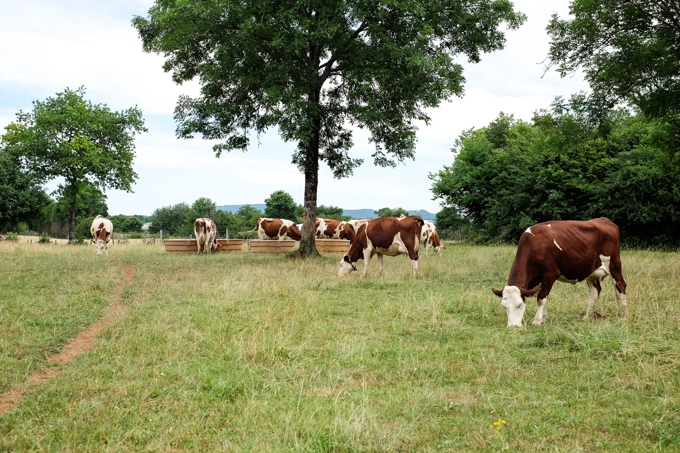What is Comté? The Golden Essential of Every Cheeseboard

Comté is not just a cheese, it’s a testament to centuries-old traditions, an emblem of the Franche-Comté region, and a sensory journey that traverses lush pastures, tranquil mountain cellars, and the skilled hands of local cheesemakers. Each wheel of Comté tells a story – a story of heritage, craftsmanship, and an unparalleled passion for quality.
In this guide, we invite you to delve deep into the world of Comté cheese, unraveling its history, understanding its production process, appreciating its flavors, and exploring its place on your cheeseboard.
Whether you’re a novice to the world of gourmet cheeses or a seasoned connoisseur, this guide will enlighten you about the golden marvel that is Comté.
Quick Facts About Comté Cheese
| Comté Cheese Quick Facts | Description |
|---|---|
| Origin | France |
| Milk Source | Cow’s milk |
| Texture | Firm and supple |
| Flavor | Complex, nutty and slightly sweet |
| Color | Pale yellow |
| Aging Process | Typically aged for 8 to 36 months |
| Uses | Ideal for snacking, grating over dishes, or melting in traditional French cuisine |
| Production Process | Made from unpasteurized cow’s milk, the curds are pressed into large wheels and aged |
Comté is a French cheese made from unpasteurized cow’s milk in the Franche-Comté region of eastern France. The cheese is produced in large wheels (up to 70 cm in diameter) and has a distinctive pale yellow interior with a brownish-grey rind. The flavor of Comté can vary depending on its age, but it generally has a complex, nutty, and slightly sweet taste.
The production process of Comté is strictly regulated – it has a Protected Designation of Origin (PDO) status by the European Union, which means that only cheeses produced in a specific way in the designated area can be called Comté.
What is special about Comté cheese?
Comté cheese is special for several reasons:
- Region-Specific Production: Comté cheese is exclusively produced in the Franche-Comté region of eastern France. This gives it a unique flavor that cannot be replicated elsewhere.
- Traditional Methods: The production process of Comté cheese follows traditional methods that have been passed down through generations. Each wheel is handmade by skilled cheesemakers, using raw milk from Montbéliarde or French Simmental cows that graze on natural pastures.
- AOC Protected: Comté has been granted AOC (Appellation d’Origine Contrôlée) and PDO (Protected Designation of Origin) status. This means that every aspect of its production, from the specific breed of cows to the area of production and aging process, is strictly regulated to ensure authenticity and quality.
- Flavor Complexity: Comté cheese is known for its complex flavor profile which can include notes of fruit, nuts, caramel, and even chocolate. Its flavor can change based on factors such as the diet of the cows, the season of production, and the length of aging.
- Aging Process: Comté cheese is aged for a minimum of 4 months, but some varieties are aged for over a year. This aging process contributes to the development of the cheese’s rich and complex flavor.
- Versatility: Comté is extremely versatile. It can be used in a variety of dishes, from fondue and gratin to salads and sandwiches, or simply enjoyed on its own with a glass of wine.
What does Comté cheese taste like?

Comté cheese is renowned for its complex and sophisticated flavor profile. The taste can vary based on several factors including the season in which it’s produced, the specific diet of the cows, and the length of aging, but there are some common characteristics that define its unique taste.
At its core, Comté has a nutty and slightly sweet flavor. It’s often described as having a creamy, fruity taste with hints of grass and hay. This reflects the natural diet of the cows whose milk is used to produce the cheese.
As the cheese matures, it develops deeper flavors. Notes of brown butter and roasted nuts become more prominent, and there may be hints of caramel or even chocolate. The texture also changes with age, becoming more firm and crystalline.
One of the intriguing aspects of Comté is its balance of flavors. It has the right amount of saltiness, a subtle sweetness, and a mild bitterness that rounds out the taste. This balance, combined with the depth and variety of flavors, makes Comté a truly distinctive and enjoyable cheese.
Comté Tasting notes
- Texture: The texture of Comté ranges from pliable and smooth in younger cheeses to firm and slightly crystalline in older varieties.
- Color: It has a pale yellow to golden color, reflecting the rich diet of the cows whose milk is used to produce it.
- Aroma: The aroma of Comté is fresh and slightly sweet, reminiscent of cream and freshly cut hay.
- Flavor: In terms of flavor, Comté is complex and multifaceted. Expect a balance of savory, sweet, and slightly tangy notes.
- Savory Notes: The savory flavors can be likened to brown butter and roasted nuts.
- Sweet Notes: On the sweeter side, you may detect hints of caramel, stone fruits like apricots, and even a slight chocolate note in well-aged varieties.
- Tangy Notes: There’s also a mild acidity, which adds a refreshing tanginess that balances out the rich and creamy profile.
- Aftertaste: The aftertaste of Comté is long-lasting and pleasant, with lingering notes of nuttiness and cream.
The exact taste can vary based on factors like the age of the cheese, the season of production, and the specific diet of the cows. This makes each wheel of Comté a unique tasting experience!
Is Comté cheese similar to Parmesan?
Comté cheese and Parmesan do share some similarities, but they also have significant differences.
Similarities:
- Both Comté and Parmesan are hard cheeses that can be grated.
- They both have a complex flavor profile and are revered for their unique taste.
- Both cheeses are often used in cooking, particularly in dishes that require a flavorful cheese that melts well.
Differences:
- Origin: Comté is a French cheese produced in the Franche-Comté region, while Parmesan, or Parmigiano Reggiano, is an Italian cheese from the Parma and Reggio Emilia regions.
- Flavor: Comté has a nutty and slightly sweet flavor with notes of butter and roasted nuts. Parmesan, on the other hand, is known for its rich, savory, and slightly salty flavor.
- Texture: Comté tends to be more pliable and smooth, especially when young, while Parmesan is typically harder and more crumbly.
- Aging Process: Parmesan is usually aged longer than Comté, often between 12 to 36 months compared to Comté’s minimum aging time of 4 months.
While Parmesan can be used as a substitute for Comté in some recipes, the two cheeses have distinct characteristics that make each one special in its own right.
>> Click here to read our in-depth guide on Parmesan
Is Comté similar to Gruyère?
Comté and Gruyère are quite similar in many respects, and they are often compared due to their shared characteristics. They are both hard, cow’s milk cheeses that originate from the same general region of Europe—Comté from eastern France and Gruyère from western Switzerland.
Similarities:
- Texture: Both have a firm, dense texture that is slightly pliable.
- Flavor Profile: Both cheeses have a complex flavor profile, with sweet, nutty, and slightly fruity notes.
- Uses: Comté and Gruyère are both versatile in the kitchen and can be used in a variety of dishes, from gratins and quiches to fondue and sandwiches. They also melt beautifully, making them excellent for cooking.
Differences:
- Aging Process: While both cheeses are aged, Gruyère is typically aged for a bit longer than Comté. This results in Gruyère having a slightly stronger and more assertive flavor.
- Taste: Despite their similarities, the taste of the two cheeses is not identical. Comté tends to have more of a fruity and nutty flavor, while Gruyère has a more pronounced earthy and savory flavor.
While both cheeses share many characteristics, they each have distinctive flavors that make them unique. If you enjoy one, it’s very likely you’ll appreciate the other!
>> Click here to read our in-depth guide on Gruyère
Is Comté similar to Cheddar?
| Characteristic | Comté | Cheddar |
|---|---|---|
| Origin | Franche-Comté region, France | Village of Cheddar, Southwest England |
| Flavor | Sweet, nutty, slightly fruity | Ranges from mild to sharp, with a distinct tangy flavor |
| Aging Process | Usually aged for a minimum of 4 months, with some varieties aged for over a year | Aging time varies greatly—from a few months for mild Cheddar to over two years for extra sharp varieties |
| Color | Pale yellow, not dyed | Naturally white to pale yellow, but often dyed to a deep orange color |
| Texture | Firm but slightly pliable, smoother texture | Firm, more crumbly especially when aged |
| Uses | Versatile, used in a variety of dishes including sandwiches, gratins, fondue | Versatile, used in a wide range of dishes from sandwiches to cheese sauces |
>> Click here to read our in-depth guide on Cheddar
Is Comté a healthy cheese?
Comté can be considered a healthy cheese due to its nutritional content. Here are some of the key health benefits associated with Comté cheese:
- High in Calcium: Comté is an excellent source of calcium, a vital mineral essential for bone health and the proper functioning of the nervous system. A 30g serving contains about 21% of your recommended daily intake of calcium.
- Good Source of Protein: Comté is a good non-meat source of protein. This is beneficial for muscle growth and repair.
- Rich in Nutrients: Like most fine cheeses, Comté is rich in nutrients like protein, calcium, zinc, phosphorus, magnesium, vitamins A, B2, and B12. These play a crucial role in many bodily functions.
- Low in Sodium: Compared to many other cheeses, Comté (also known as Gruyère) is relatively low in sodium, which is beneficial for those watching their salt intake.
However, it’s worth noting that Comté is also high in calories and fat. There are between 380 and 400 kcal in a 100-gram portion of Comté, making it one of the higher calorie cheeses.
As with all foods, it should be consumed in moderation as part of a balanced diet.
Comté nutrition facts
| Nutrient | Amount per 100g |
|---|---|
| Calories | 380-400 kcal |
| Protein | Approximately 25g |
| Total Fat | Around 32-36g |
| Carbohydrates | 0g |
| Calcium | 298mg per 30g serving (about 994mg per 100g) |
Also read: Savor the Flavor: 20 Cheeses with the Least Lactose
What is the best way to eat Comté cheese?
- On its Own: Comté is delicious by itself, allowing you to fully appreciate its unique flavors. Pair it with a glass of white wine for a simple yet elegant snack.
- Cheese Board: Include Comté in a cheese board with a variety of other cheeses. It pairs well with fresh fruits like apples and grapes, dry fruits like figs and dates, and nuts like almonds and walnuts.
- Cooking: Comté melts beautifully, making it perfect for use in gratins, quiches, or on top of soups. It’s also great in sandwiches, especially melted in a croque monsieur.
- Fondue: Comté is often used in traditional Swiss fondue recipes, either on its own or mixed with other cheeses like Gruyère.
- Salads: Shave or crumble Comté over salads for a burst of flavor and a touch of elegance.
What pairs well with Comté cheese?
Food that goes well with Comté
| Category | Foods |
|---|---|
| Fresh Fruits | Apples, Pears, Grapes |
| Dried Fruits | Figs, Dates, Apricots |
| Nuts | Almonds, Walnuts, Hazelnuts |
| Bread | Baguette, Sourdough, Rye Bread |
| Charcuterie | Prosciutto, Salami, Sausage |
| Other Cheeses | Brie, Gruyère, Roquefort |
| Condiments | Honey, Fig Jam, Mustard |
| Vegetables | Tomatoes, Avocado, Bell Peppers |
| Salad Greens | Arugula, Spinach, Mixed Greens |
Also read: What Fruit Goes on a Charcuterie Board?
Beverage that goes well with Comté
| Category | Beverages |
|---|---|
| White Wine | Chardonnay, Sauvignon Blanc, Riesling |
| Red Wine | Pinot Noir, Merlot, Cabernet Sauvignon |
| Sparkling Wine | Champagne, Prosecco, Cava |
| Fortified Wine | Sherry, Port, Madeira |
| Beer | Belgian Ale, Stout, Lager |
| Non-Alcoholic | Sparkling Water, Apple Cider, Grape Juice |
Also read: A Comprehensive Guide to Enjoying Cheese Platter with Wine
What are the best Comté substitutes?
- Gruyère: This Swiss cheese has a slightly sweet and nutty flavor, similar to Comté.
- Emmental (or Emmentaler): Another Swiss cheese, it stands tall as a worthy substitute for Comté with its nutty and slightly sweet taste.
- Beaufort: This cheese from the French Alps has a unique aroma and a delicate flavor that can stand in for Comté.
- Gouda: A Dutch cheese known for its rich, unique flavor and smooth texture.
- Fontina: An Italian cheese that’s slightly creamy with a nutty flavor, making it a good match for Comté.
- Raclette: This Swiss cheese is known for its excellent melting properties, much like Comté.
- Jarlsberg: A Norwegian cheese that’s mildly sweet and nutty, making it a good substitute for Comté.
Where to buy Comte Cheese?
- Fromages.com: This online platform connects customers directly with local French producers and farmers to order Comté Cheese.
- La Fromagerie: With three locations in San Francisco, La Fromagerie offers a huge selection of traditional French cheeses, including Comté.
- Amazon: Comté French Aged Cheese is available for purchase by the pound on Amazon.
The history of Comté

Comté, also known as Gruyère de Comté, is a French cheese with a rich history that dates back over a thousand years. It’s produced in the Jura Massif region of Eastern France, an area known for its unique micro-climates and diverse flora, which contribute to the distinct flavor and aroma of Comté.
The production of Comté began in the early Middle Ages, around the 12th century. During the harsh winter months, farmers in the Jura Massif region found it difficult to travel, so they began transforming their excess milk into cheese, allowing them to preserve it for longer periods. The cheese-making process was a community effort, with neighboring farms pooling their milk together to create large wheels of Comté, each typically weighing between 40 and 50 kilograms.
In 1958, Comté received AOC (Appellation d’Origine Contrôlée) status, recognizing its unique link to its geographical origin. This means that only cheese produced in this specific region, using traditional methods and raw milk from Montbéliarde or French Simmental cows, can be called Comté.
Today, Comté remains one of the most popular cheeses in France, prized for its complex flavor profile that can vary based on factors such as the time of year it’s produced and the specific micro-region within the Jura Massif where it’s made. Each wheel of Comté is a reflection of its terroir, the specific combination of climate, geography, and human skill that makes each cheese unique.
Frequently Asked Questions
1. Does Comté cheese need to be refrigerated?
Yes, Comté cheese needs to be refrigerated. According to various sources, Comté cheese is typically found pre-cut and refrigerated in stores. It’s either vacuum-packed by the producer in France or cut/wrapped locally. The ideal and preferable temperature for storing this cheese is in a cold and dark area.
Furthermore, if you have any dishes with cooked Comté, they should also be stored in the fridge and can last up to 3 days. Any large wheels of Comté cheese need to be stored at 41 degrees Fahrenheit or cooler.
Remember, not all cheeses require refrigeration, but cold storage is crucial for many types, including Comté. Refrigeration slows the rate of both the aging process and the growth of mold.
Also read: What’s the Best Way to Store Cheese?
2. Can you eat Comté cheese raw?
Yes, you can eat Comté cheese raw. It is often enjoyed as is, or included in cheese platters, sandwiches, and salads.
Like with any cheese, if you’re eating it raw, let it sit at room temperature for about an hour before eating to fully enjoy its flavors.
3. Do you cut the rind off Comté cheese?
Yes, typically the rind of Comté cheese is cut off before eating. The rind is hard and has a different texture from the rest of the cheese.
However, it is edible and some people do choose to eat it – it’s really up to personal preference.
If you find the taste or texture of the rind unpleasant, feel free to remove it. Just be sure to cut it away carefully so as not to waste any of the delicious cheese!
4. What are the white dots on Comté cheese?
The white dots that you see on Comté cheese, and many other types of aged cheese, are called tyrosine crystals. These are a sign of a well-aged cheese.
As the cheese matures, proteins break down and can recombine into these small, crunchy deposits.
They are completely safe to eat and add a pleasant crunch and flavor to the cheese. So if you see these little white dots in your Comté cheese, it’s not only normal but a sign of good quality and proper aging.
5. Why is it called Comté cheese?
Comté cheese is named after the region in France where it is produced – the Franche-Comté region. This area, located in eastern France near the Swiss border, has a rich history of cheese-making. The name “Comté” literally translates to “county” in English.
6. How do you pronounce Comté cheese?
Comté cheese is pronounced as “com-tay”. The accent at the end of the word in French indicates that you should stress that syllable.
7. Is Comté suitable for a pregnant woman?
Yes, Comté cheese is generally considered safe for pregnant women to consume. This is because Comté is a type of hard, pressed cheese that undergoes a significant aging process.
According to the FDA and FSANZ, Comté, along with other pressed cheeses, are safe for both mother and baby during pregnancy. However, it’s always recommended to consult with a healthcare professional or dietitian when introducing new foods during pregnancy.
Please note that while the cheese itself is safe, pregnant women are often advised not to consume the crust.
Also, it’s worth noting that some Comté cheese is made from raw milk, which some health authorities advise pregnant women to avoid due to the risk of bacterial contamination. If the Comté cheese is made from pasteurized milk, it should be safe to consume.
Remember, every individual’s health condition and dietary needs may vary, so it’s always a good idea to consult with a healthcare provider when in doubt.
Also read:
- The Ultimate Guide to Gruyère: A Swiss Delicacy
- Mastering the Art of Smoked Gouda: Your Ultimate Cheese Guide
- Pecorino Romano: The Ultimate Guide to Italy’s Age-Old Cheese
- Utz Cheese Balls: The Ultimate Guide (Taste the Tradition)
- The Ultimate Guide to Raclette Cheese: A Melted Delight
- Cheese Curds: The Unsung Heroes of the Dairy World
- Fior di Latte: A Comprehensive Guide to Italy’s Creamy Delight





